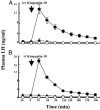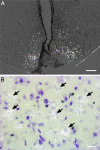Increased hypothalamic GPR54 signaling: a potential mechanism for initiation of puberty in primates
- PMID: 15684075
- PMCID: PMC548549
- DOI: 10.1073/pnas.0409822102
Increased hypothalamic GPR54 signaling: a potential mechanism for initiation of puberty in primates
Abstract
To further study the role of GPR54 signaling in the onset of primate puberty, we used the monkey to examine the ability of kisspeptin-10 to elicit the release of gonadotropin-releasing hormone (GnRH) precociously, and we describe the expression of GPR54 and KiSS-1 in the hypothalamus during the peripubertal period. Agonadal juvenile male monkeys were implanted with a lateral cerebroventricular cannula and a jugular vein catheter. The responsiveness of the juvenile pituitary to endogenous GnRH release was heightened with a chronic pulsatile i.v. infusion of synthetic GnRH before kisspeptin-10 (112-121) injection. Intracerebroventricular (30 microg or 100 microg) or i.v. (100 microg) bolus injections of kisspeptin-10 elicited a robust GnRH discharge, as reflected by luteinizing hormone secretion, which was abolished by pretreatment with a GnRH-receptor antagonist. RNA was isolated from the hypothalamus of agonadal males before (juvenile) and after (pubertal) the pubertal resurgence of pulsatile GnRH release and from juvenile, early pubertal, and midpubertal ovary-intact females. KiSS-1 mRNA levels detected by real-time PCR increased with puberty in both male and female monkeys. In intact females, but not in agonadal males, GPR54 mRNA levels in the hypothalamus increased approximately 3-fold from the juvenile to midpubertal stage. Hybridization histochemistry indicated robust KiSS-1 and GPR54 mRNA expression in the region of the arcuate nucleus. These findings are consistent with the hypothesis that GPR54 signaling by its cognate ligand in the primate hypothalamus may be activated at the end of the juvenile phase of development and may contribute to the pubertal resurgence of pulsatile GnRH release, the central drive for puberty.
Figures





References
-
- Lee, D. K., Nguyen, T., O'Neill, G. P., Cheng, R., Liu, Y., Howard, A. D., Coulombe, N., Tan, C. P., Tang-Nguyen, A.-T., George, S. R. & O'Dowd, B. F. (1999) FEBS Lett. 446, 103-107. - PubMed
-
- Seminara, S. B., Messager, S., Chatzidaki, E. E., Thresher, R. R., Acierno, J. S., Shagoury, J. K., Bo-Abbas, Y., Kuohung, W., Schwinof, K. M., Hendrick, A. G., et al. (2003) N. Engl. J. Med. 349, 1614-1627. - PubMed
-
- Funes, S., Hedrick, J. A., Vassileva, G., Markowitz, L., Abbondanzo, S., Golovko, A., Yang, S., Monsma, F. J. & Gustafson, E. L. (2003) Biochem. Biophys. Res. Commun. 312, 1357-1363. - PubMed
-
- Kotani, M., Detheux, M., Vandenbogaerde, A., Communi, D., Vanderwinden, J.-M., Poul, E. L., Brezillon, S., Tyldesley, R., Suarez-Huerta, N., Vadenput, F., et al. (2001) J. Biol. Chem. 276, 34631-34636. - PubMed
Publication types
MeSH terms
Substances
Grants and funding
- HD08610/HD/NICHD NIH HHS/United States
- P50 HD028138/HD/NICHD NIH HHS/United States
- P30 HD028138/HD/NICHD NIH HHS/United States
- R01 HD015788/HD/NICHD NIH HHS/United States
- U54 HD029164/HD/NICHD NIH HHS/United States
- P30 HD008610/HD/NICHD NIH HHS/United States
- HD18185/HD/NICHD NIH HHS/United States
- P51 RR000163/RR/NCRR NIH HHS/United States
- RR00163/RR/NCRR NIH HHS/United States
- R01 HD013254/HD/NICHD NIH HHS/United States
- HD25123/HD/NICHD NIH HHS/United States
- R01 HD043341/HD/NICHD NIH HHS/United States
- K01 RR000163/RR/NCRR NIH HHS/United States
- HD28138/HD/NICHD NIH HHS/United States
- R01 HD025123/HD/NICHD NIH HHS/United States
- P30 HD018185/HD/NICHD NIH HHS/United States
- U54 HD028138/HD/NICHD NIH HHS/United States
- HD13254/HD/NICHD NIH HHS/United States
- U54 HD018185/HD/NICHD NIH HHS/United States
- U54 HD008610/HD/NICHD NIH HHS/United States
LinkOut - more resources
Full Text Sources
Other Literature Sources
Medical

